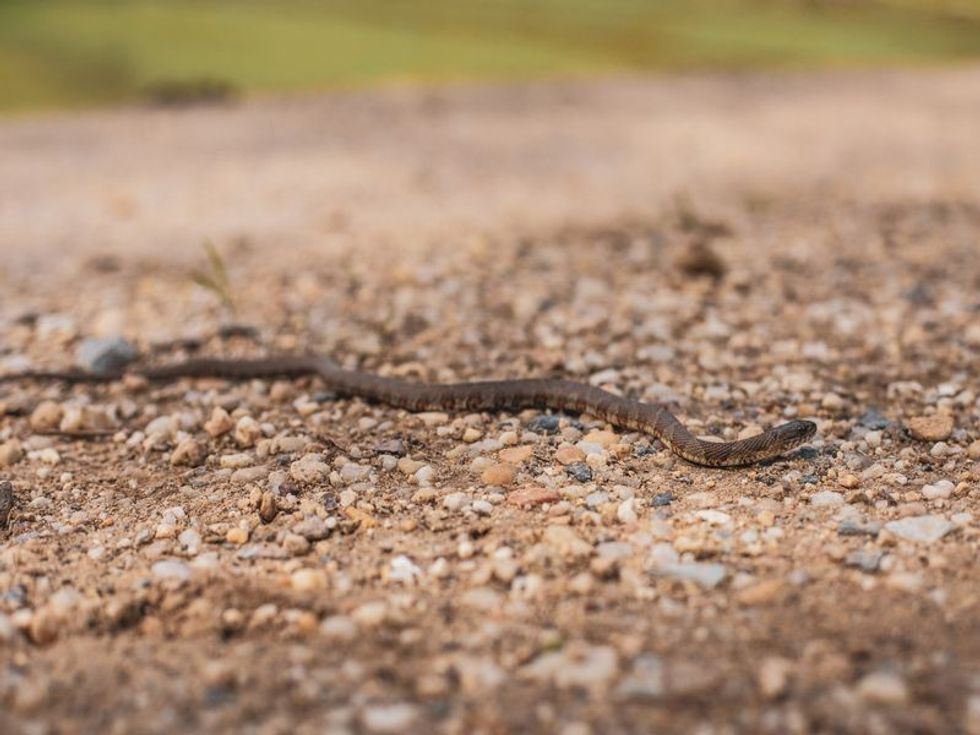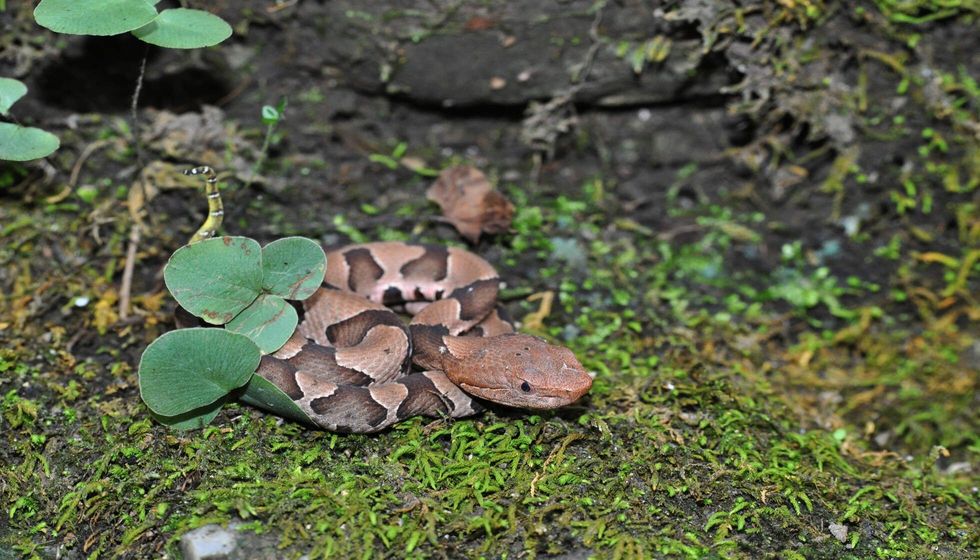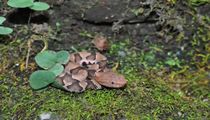How To Identify A Baby Copperhead Snake? Key Features With Pictures

The copperhead is a snake species from the Reptilia class.
Baby copperheads are short snakes and cute because they display various shades. The length of a copperhead's teeth is related to the length of the snake.
This species breeds in the summer and typically delivers babies between late August and early September. They are most likely encountered in North America, Kentucky, West Virginia, Missouri, Arkansas, Tennessee, Louisiana, northern Carolina, Mississippi, Alabama, Texas, and Georgia.
As an abundance of baby copperhead snakes enters the world, there are some precautions you should take and things you should know about the venomous species. The northern Carolina Wildlife Commission reported that 90% of snake bites in the state come from a copperhead snake.
These snakes have a body coloration of reddish or light brown, and yellow.
One can differentiate the adults from the young ones by identifying them from their green lines or bright yellow coloration on their tails in particular. This snake species is often confused with the harmless eastern ratsnake juvenile since they look alike.
Baby copperhead's bites are one of the most well-known venomous snake bite events in North America. Luckily, they aren't very harmful.
However, you should in any case be mindful around them and you should be quick in identifying them to avoid such bites. Baby Copperheads are venomous, this implies that a copperhead bite (regardless of whether from a grown-up or baby) is probably going to be painful.
Further, any venomous snake bite should expect prompt medical attention. A bite could prompt extremely durable tissue and nerve harm or surprisingly more dreadful.
In the event that you think you have been bitten by a snake (yet you don't know which type), seek medical attention immediately after any snake bite. The most well-known snake misidentified as a copperhead is the harmless adolescent Eastern Ratsnake.
The Eastern Ratsnake begins existence with a solid pattern of dark or earthy colored blotches on a pale dim foundation. As the Eastern Ratsnake ages, the pattern blurs and the snake becomes dark, regularly with simply a trace of the adolescent pattern remaining.
If you are looking for similar fun fact animal contents, you can also visit these how to cut tomatoes and how to bathe a guinea pig.
What are the key features of a copperhead snake?
Copperhead (Agkistrodon contortrix) snakes are poisonous snakes found mostly in the eastern and central United States. Copperheads are occasionally confused with other snakes. Copperheads are known by a variety of names, including copper viper, red viper, hazel heads, poplar leaf snake, and excellent country slipper.
When you realize what to search for, you can figure out how to distinguish the copperhead snake. They look quite different from other snake species. They are quite tiny and one can hold them in their palm.
How does a copperhead snakes wind get its name? The copperhead snakehead is to be sure a coppery, rosy earthy colored tone for certain specks on the top. The snake's triangle-molded head is huge with respect to its smaller neck.
Copperheads are massive snakes and reach up to around 3 ft (91.44 cm) long in development. Their eyes have cut like students like feline's eyes.
They now and again vibrate their bright yellow tail, however for the most part they stay still and in a snaked position to snare prey. Copperheads can swim if important. The adult copperhead can reach up to 2-3 ft (60.96-91.44 cm) long.
Copperheads snakes are pit vipers. The copperhead snake's head has a pit in its face that identifies heat.
This can assist them with finding prey in dull sections or around evening time. They can even tell the overall size of their prey around evening time!
On each side of the front, between the nose and the eye, the copperhead looks like a pit viper. Copperhead snakes have two special heat-sensing pit-like organs.
Its eyes have a vertical elliptical-shaped head. Like other snakes, it has a zigzag tongue.
From baby copperhead snakes, it has hollow, folding fangs at the front of the mouth. Baby copperhead snake teeth typically contain about 0.5 in (1.27 cm) long, while slightly bigger ones can reach 10 in (25 cm). A baby copperhead bites its prey, and its tooth toxin separates red platelets in the prey to immobilize it.
Contingent upon the sort of prey they seek after, copperheads can change their toxin supply. Copperhead chomps regularly happen when somebody steps on one of the snakes or in any case contacts them.
While the chomp of a copperhead is toxic, it seldom kills people. For the most part, copperheads don't need anything to do with people.
The baby copperheads have a relatively compact body, which is around 2-3 ft (60.96-91.44 cm) in length and weighs 0.33-0.75 lb (151.2-340.2 g). Regardless of this, never trouble a snake in the event that you would prefer not to be copperhead bites!
How to identify a copperhead snake?
The dread of being chomped by a snake stresses numerous people if the snake is venomous. There are 38 types of snakes found in South Carolina, yet just six are venomous snakes.
The venomous snakes found in South Carolina are all pit snakes with one exemption. The pit vipers incorporate copperhead, cottonmouth, pigmy rattler, diamondback poisonous snake, and lumber poisonous snake. Pit snakes get their name from having a warmth detecting pit situated between their eyes and their noses, which assists these snakes with finding their warm-blooded prey.
There are multiple approaches to distinguish the copperhead snakes from these two same-looking snake species. How about we start with a portrayal of the copperhead snakes.
The baby copperhead snake gets its name from the coppery-tan shading discovered chiefly on its heads and. All through pieces of its body down to the tail.
Baby copperhead average length ranges about 8-10 in (20.32-25.4 cm) long when born. This is pretty tiny, so people do not recognize adult snakes as dangerous the first time. Since the copperhead snake is a snake, you will notice an exceptionally unmistakable three-sided shaped head.
Some individuals consider it a pointed stone molded head. These more extensive pieces of the heads consider space to fit snake's teeth and toxin organs.
The baby copperhead pattern portion takes after an hourglass and is one of the most analytic qualities of all.
The hourglass shape lays to some degree sideways on the copperhead's back; the more extensive piece of the shape effects on one side of the body reduces towards the center top edge of the back and afterward increases back out to the contrary side of the snake.
To lay it out plainly, the highest point of the hourglass contacts the left half of the body, the lower part of the hourglass contacts the right half of the body.
Remember that the hourglass-shaped can periodically mismatch and seem like baby copperhead snakes detach from the total shape, particularly towards the tail.
Baby copperhead snakes have a yellow eye with a dark vertical and circular pupil, looks like a cat's eye. Kindly be prompted that this requires extraordinary vision & amazing perspective.
Nonetheless, do not attempt to get excessively near the snake to see this component, as you may place yourself at serious risk and eventually incite a strike from the snake. The venomous coral snake remaining nonvenomous snakes south Carolina snakes have round pupils.
Identify (juvenile) Adult copperheads are recognized for having a bright yellow tail, that they practice drawing their prey, like frogs and little reptiles. From birth, they have practical toxin organs yet can't handle the measure of toxins that juvenile copperheads infuse. Subsequently, you might end up with a more difficult baby copperhead bite as opposed to Adult copperheads.
The corn snake is one of a few northern American types of rodent snake. In contrast to copperheads, corn snakes do not have teeth yet catch and stifle corn snakes' prey by tightening.
Corn snakes are one of the most common types of snakes mistaken for copperheads. Corn snakes are more interesting than baby copperheads. Baby copperheads have a few shading variations yet are ordinarily redder in shading instead of the baby copperhead copper-tan coloring.
The northern water snake is a huge, nonvenomous normal snake local to North American. The northern water snake's base tone is brown or dim with more obscure brown, ruddy, or dark groups on the back formed like an opposite hourglass. water snakes are the snake most usually overlooked for the copperhead.
This is common, likely because of Water snakes same pattern and colors. The gut is generally white, yellowish, or orange.
What does a copperhead snake look like?
The baby copperhead looks like an adult snake. Copperheads are so named because their heads have ruddy, coppery shading. Both adult copperheads and baby copperheads show this element.
They additionally normally have two little, dull spots on the highest point of their heads however, some might not have the spots. Other than the spots, there is no pattern on the heads of copperhead snakes.
The body of a baby copperhead is normally a daylight natural or slightly pink shade. Sometimes baby copperheads are more grayish than adults but adopt a more brown color as they age. Along the back of the baby, a snake is dark brown or reddish-brown markings.
The stomach of the baby copperhead is typically lighter than the remainder of the body, and it frequently has a harsh or inconsistent look to it. In some cases, there are additionally dull smear-like markings at the edges of the gut.
Baby copperheads do have one element that makes them stand apart from grown-up copperheads. They have dazzling yellowtail that they can use to assist stunt with preying into drawing close. The baby squirms its yellow tail to make little animals think it is a worm.
When the prey is close to enough, the snake attacks it. As copperheads age, the yellow-hued tail tip blurs to a shading nearer to the shade of the remaining of the body.

How to get rid of copperhead snakes?
If a baby copperhead is in your yard, there are a couple of ways to eliminate it securely and productively to stay away from an advanced rehash of this calamity. Utilize a brush to push it back outside, get a snake trap, call an expert bug control organization.
Copperhead snakes can be quite dangerous and they are among venomous snakes even though the amount of venom that they produce is not potent. Even if they were nonvenomous, most people should stay away from snakes, especially the wild ones.
Copperheads may nibble and will assuredly become forceful, so watch your environmental factors. Utilizing a push-brush, you can cautiously move the snake out of your front entryway, so it is at this point not within your yard.
If you have experienced a baby copperhead snake in your yard or live in a space where they are normal, read on to figure out how you can avoid this snake from your property.
Numerous homeowners favor the choice of getting a snake trap. These are either extreme paste sheets or metal enclosures.
The snake will be drawn to the smell of attraction and will become trapped in the past or a correctional facility of the metal snare. You can let the snake outside a protected distance out of your yard, where it will not effectively discover its direction back. At last, the last alternative: you can contact an expert.
Since copperhead is a venomous snake, this is the most intelligent alternative. Experienced snake controllers can kill serpentine dangers rapidly and effectively, so you don't need to worry about being bitten by a dangerous intruder.
Three steps to get rid of copperhead snakes:
Stage one: Remove food sources. The initial step is fairly obvious. You should firmly close all garbage bins outside that might contain extra food. Extras from your table draw in rodents, which thus are nourishment for snakes.
Stage two: Seal the entry points. Disposing of copperheads, remember to close all passages to the house for them.
Seal any openings in your dividers, carport, or storm cellar utilizing a fixing firearm and sealant to prevent snakes from looking for cover in your home. Eliminate all unfamiliar articles from your home, nursery, and yard. Dispense with the heaps of stones, and cut the high grass.
Stage three: Getting rid of copperheads. Probably the least complex approach to getting rid of snakes is to dispose of their nests within your home. Copperhead snakes have smaller spots.
Additionally, when you disperse snake repellent all around the yard, you make the conditions hard for them to live in. Then, at that point, you can free the snake in any spot that is a long way from your home. Additionally, a group of experts will either eliminate the reptile or catch it and take it to another area.
Here at Kidadl, we have carefully created lots of interesting family-friendly facts for everyone to enjoy! If you liked our suggestions for how to identify a baby copperhead snake, then why not take a look at how to bathe a cat or copperhead snake facts?
We Want Your Photos!
More for You
Bachelor of Science specializing in Microbiology

Oluwatosin MichaelBachelor of Science specializing in Microbiology
With a Bachelor's in Microbiology from the Federal University of Agriculture, Abeokuta, Ogun State, Oluwatosin has honed his skills as an SEO content writer, editor, and growth manager. He has written articles, conducted extensive research, and optimized content for search engines. His expertise extends to leading link-building efforts and revising onboarding strategies.
Disclaimer
1) Kidadl is independent and to make our service free to you the reader we are supported by advertising. We hope you love our recommendations for products and services! What we suggest is selected independently by the Kidadl team. If you purchase using the Buy Now button we may earn a small commission. This does not influence our choices. Prices are correct and items are available at the time the article was published but we cannot guarantee that on the time of reading. Please note that Kidadl is a participant in the Amazon Services LLC Associates Program, an affiliate advertising program designed to provide a means for sites to earn advertising fees by advertising and linking to Amazon. We also link to other websites, but are not responsible for their content.
2) At Kidadl, we strive to recommend the very best activities and events. We will always aim to give you accurate information at the date of publication - however, information does change, so it’s important you do your own research, double-check and make the decision that is right for your family. We recognise that not all activities and ideas are appropriate for all children and families or in all circumstances. Our recommended activities are based on age but these are a guide. We recommend that these ideas are used as inspiration, that ideas are undertaken with appropriate adult supervision, and that each adult uses their own discretion and knowledge of their children to consider the safety and suitability. Kidadl cannot accept liability for the execution of these ideas, and parental supervision is advised at all times, as safety is paramount. Anyone using the information provided by Kidadl does so at their own risk and we can not accept liability if things go wrong.
3) Because we are an educational resource, we have quotes and facts about a range of historical and modern figures. We do not endorse the actions of or rhetoric of all the people included in these collections, but we think they are important for growing minds to learn about under the guidance of parents or guardians.







